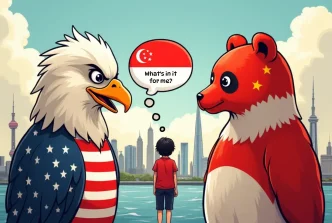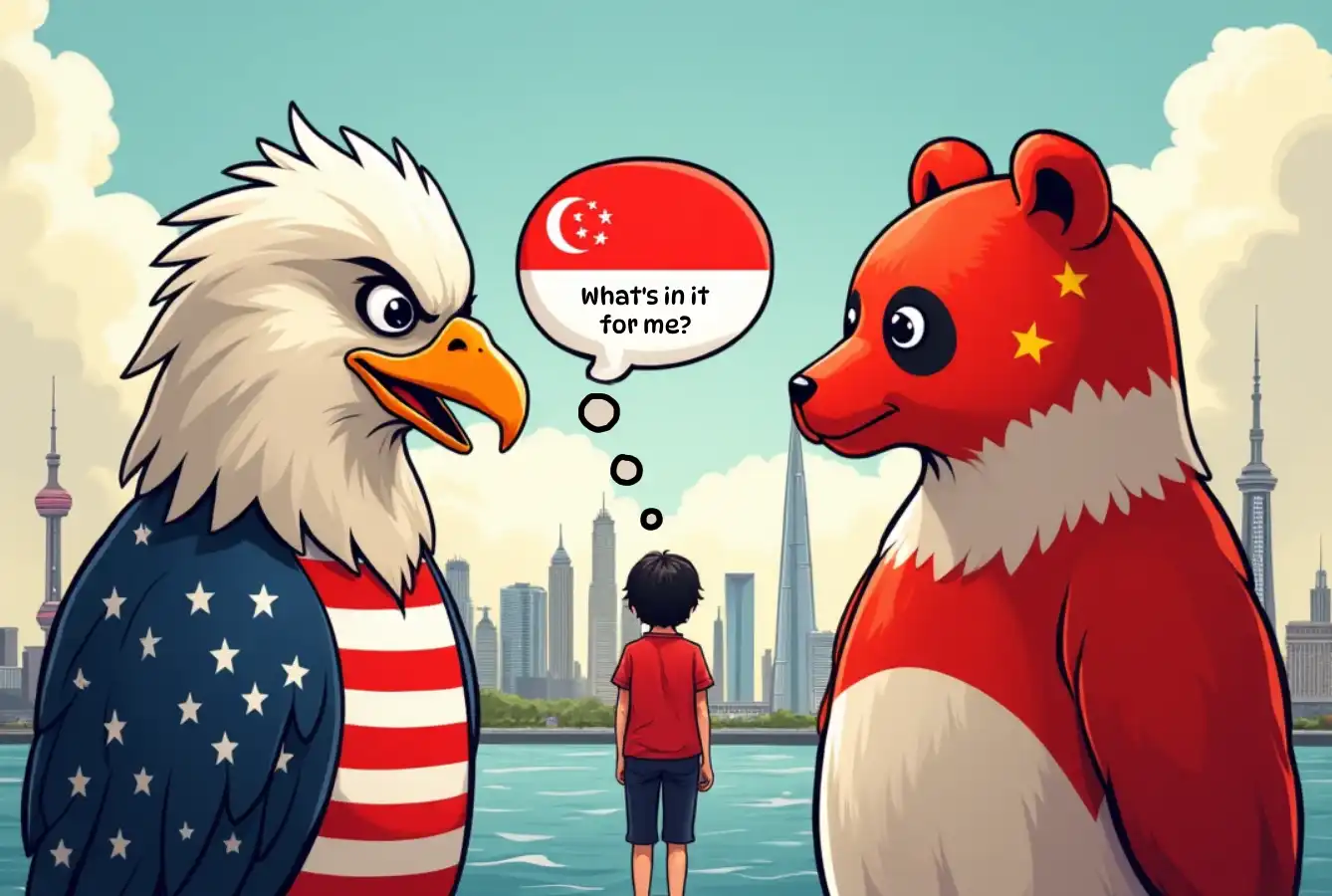Singapore, a small but economically vital city-state, finds itself at the crossroads of escalating trade tensions between the United States and China, two of its most significant trading partners. Speaking at the Wealth Edition of the UBS Asian Investment Conference on May 22, 2025, Deputy Prime Minister and Trade and Industry Minister Gan Kim Yong emphasized that neutrality is not an option for Singapore. Instead, the nation must carve out positions based on its own interests, a stance that grows increasingly complex as global trade dynamics shift.
A Delicate Balancing Act
In his dialogue with Young Jin Yee, co-head of UBS Global Wealth Management Asia-Pacific, DPM Gan underscored Singapore’s commitment to engaging with both the US and China. “We do take positions. The only difference is that we take positions not because you are the US or because you are China” he said. Rather, decisions are rooted in what benefits Singapore and its citizens, a principle that guides the nation through the murky waters of international trade disputes.
Yet, this approach is not without challenges. DPM Gan acknowledged the growing difficulty in finding a path that satisfies both global powers. The temporary reprieve offered by the May 12, 2025, agreement between the US and China—suspending tariffs on each other’s goods for 90 days—offers a brief window of calm. However, uncertainty looms over what will unfold once this truce expires. As DPM Gan warned, the end of this tariff crisis will not mark a return to business as usual. “It is going to be a new world” he said, hinting at a transformed global economic landscape.
The Roots of a Changing Global Order
The trade tensions between the US and China are emblematic of broader shifts in international economic policy. DPM Gan traced the origins of these challenges back to years of difficult negotiations at the World Trade Organization, long before recent escalations. He pointed to US President Donald Trump’s announcement of reciprocal tariffs on April 2, dubbed “Liberation Day” by some, as a turning point that intensified global trade disputes. This move, coupled with a growing focus on domestic needs and protectionist policies worldwide, has complicated multilateral trade talks.
For Singapore, a nation heavily reliant on open markets and global trade, these developments pose significant risks. The city-state has historically thrived as a hub for international commerce, leveraging its strategic location and business-friendly policies. However, the rise of protectionism threatens to disrupt the free flow of goods and services that underpins its economy. DPM Gan’s remarks reflect a deep concern for how Singapore can maintain its competitive edge in this evolving environment.
Strategic Responses to Economic Uncertainty
In response to these near-term challenges, the Singaporean government has taken proactive steps to safeguard its economy. In April 2025, the Singapore Economic Resilience Taskforce was established, chaired by DPM Gan himself. Comprising four other ministers and representatives from key organizations like the Singapore Business Federation, the National Trades Union Congress, and the Singapore National Employers Federation, the taskforce aims to support businesses and workers navigating the fallout from US tariffs.
The taskforce’s priorities are multifaceted. DPM Gan highlighted the importance of investing in innovation, research, and development to drive the creation of new businesses, products, services, and markets. This forward-thinking approach seeks to diversify Singapore’s economic base, reducing reliance on traditional trade routes that may be disrupted by ongoing tensions. Additionally, new business models are being explored to adapt to the changing global landscape.
Equally critical is the investment in human capital, which DPM Gan described as Singapore’s most vital resource. “Every industry, every business needs to continue to invest in developing our local talent, bringing in talent and building a team together” he said. This focus on skills development and talent acquisition is designed to ensure that Singapore’s workforce remains agile and competitive, capable of meeting the demands of a rapidly shifting economy.
Agility in a Fast-Changing World
Beyond specific policies, DPM Gan stressed the need for Singapore to remain nimble. The ability to “move fast, change fast, and respond fast” is essential in a world where the business environment can shift overnight. This adaptability has long been a hallmark of Singapore’s governance, evident in its response to past crises such as the Covid-19 pandemic. During that period, DPM Gan was part of a multi-ministry taskforce, earning him the affectionate nickname “task force man” among colleagues.
Reflecting on this collaborative approach, DPM Gan noted Singapore’s penchant for forming teams to tackle complex issues collectively. “We are quite fond of forming teams and task forces so that we are able to tackle issues collectively” he said, emphasizing that this strategy maximizes the limited resources of a small nation. He even extended an open invitation to the audience, suggesting that their expertise might one day be called upon to address future challenges. “So if one day I call upon you to help me form a new task force to deal with challenges, please do not shy away” he added with a tone of earnest appeal.
Navigating the ‘New World’
The concept of a “new world” in global trade, as articulated by DPM Gan, raises profound questions for Singapore and beyond. What will this transformed economic order look like? How can a small nation like Singapore continue to seize opportunities amidst uncertainty? These are the issues that, as DPM Gan admitted, keep him awake at night. While definitive answers remain elusive, Singapore’s strategy appears to hinge on innovation, resilience, and strategic positioning.
Analysts suggest that Singapore’s role as a mediator and trade hub could become even more critical in the coming years. By maintaining open channels with both the US and China, the city-state is well-placed to facilitate dialogue and mitigate the worst impacts of trade disputes. However, this role requires careful diplomacy to avoid being caught in the crossfire of superpower rivalry. As one economic observer noted, Singapore’s ability to balance competing interests will be tested as never before.
Moreover, the focus on domestic innovation and talent development signals a shift toward self-reliance. While Singapore will continue to prioritize international trade, investments in cutting-edge industries—such as technology and green energy—could provide a buffer against external shocks. Government initiatives to foster research and development are already bearing fruit, with Singapore ranking among the top global hubs for innovation. Yet, scaling these efforts to meet the demands of a “new world” will require sustained commitment and resources.
Global Implications of Local Actions
Singapore’s response to the US-China trade tensions also carries broader implications for the Southeast Asian region. As a leading member of ASEAN, Singapore often sets the tone for regional economic policies. Its emphasis on resilience and adaptability could inspire neighboring countries to adopt similar strategies, fostering a collective approach to global challenges. At the same time, Singapore’s unique position as a financial and trade hub means its actions are closely watched by international investors seeking stability in uncertain times.
However, the road ahead is far from certain. The temporary suspension of tariffs between the US and China offers only a brief respite, and unresolved issues could resurface with renewed intensity. For Singapore, maintaining economic growth while navigating these geopolitical currents will require both strategic foresight and tactical flexibility. DPM Gan’s candid acknowledgment of the challenges ahead reflects a pragmatic understanding of the stakes involved.
Looking to the Future
As the global economic landscape continues to evolve, Singapore stands as a case study in resilience and adaptability. The city-state’s refusal to remain neutral, coupled with its commitment to principled decision-making, offers a model for small nations grappling with the fallout of superpower rivalries. Yet, the path forward is fraught with uncertainty, and the shape of the “new world” DPM Gan foresees remains an open question.
For now, Singapore’s leaders and citizens alike are bracing for change, armed with taskforces, innovation, and a determination to safeguard their future. Whether these efforts will suffice in the face of mounting global pressures is a story still unfolding, one that will shape not just Singapore’s destiny but the broader contours of international trade for years to come.















